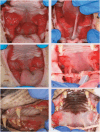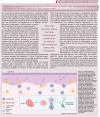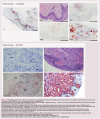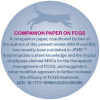Feline chronic gingivostomatitis current concepts in clinical management
- PMID: 37548475
- PMCID: PMC10811996
- DOI: 10.1177/1098612X231186834
Feline chronic gingivostomatitis current concepts in clinical management
Abstract
Practical relevance: Feline chronic gingivostomatitis (FCGS) is a debilitating disease for cats and a challenge for veterinarians and cat caregivers alike. Recent literature indicates that the disease is immune-mediated in nature and likely associated with a chronic viral infection in patients with higher alpha diversity of their subgingival microbiome. The immune-mediated nature of FCGS includes both local as well as systemic effects, and the transcriptomic analysis of affected patients supports these findings.
Treatment options: Localized therapy in the form of surgical extraction of all, or nearly all, teeth continues to be the mainstay of treatment. For cats that do not respond to surgical management, medical management, in the form of immunosuppressive or immunomodulatory therapy, remains an option. Analgesia is of fundamental importance. Immunomodulation utilizing mesenchymal stromal cell therapy provides an alternative treatment avenue for refractory patients and likely targets the chronic viral infection present in this disease. The potential for treatment stratification and use of novel systemic treatment options may be revealed as the molecular pathways involved in this disease are better described.
Aims: This review outlines current and emerging concepts linking available science pertaining to FCGS and clinical management of the disease.
Evidence base: The article draws on the best evidence base at this juncture and is also driven by the authors' collective experience of working on the disease for over a decade.
Keywords: Dentistry; gingivostomatitis; inflammation; medical therapy; oral mucosa; surgical therapy.
Conflict of interest statement
The authors declared no potential conflicts of interest with respect to the research, authorship, and/or publication of this article.
Figures




















Similar articles
-
Feline Chronic Gingivostomatitis Diagnosis and Treatment through Transcriptomic Insights.Pathogens. 2024 Feb 21;13(3):192. doi: 10.3390/pathogens13030192. Pathogens. 2024. PMID: 38535535 Free PMC article.
-
Stromal cell therapy in cats with feline chronic gingivostomatitis: current perspectives and future direction.J Feline Med Surg. 2023 Aug;25(8):1098612X231185395. doi: 10.1177/1098612X231185395. J Feline Med Surg. 2023. PMID: 37548494 Free PMC article. Review.
-
Therapeutic Efficacy of Fresh, Autologous Mesenchymal Stem Cells for Severe Refractory Gingivostomatitis in Cats.Stem Cells Transl Med. 2016 Jan;5(1):75-86. doi: 10.5966/sctm.2015-0127. Epub 2015 Nov 18. Stem Cells Transl Med. 2016. PMID: 26582907 Free PMC article.
-
Use of unbiased metagenomic and transcriptomic analyses to investigate the association between feline calicivirus and feline chronic gingivostomatitis in domestic cats.Am J Vet Res. 2021 May;82(5):381-394. doi: 10.2460/ajvr.82.5.381. Am J Vet Res. 2021. PMID: 33904799
-
An Update on Feline Chronic Gingivostomatitis.Vet Clin North Am Small Anim Pract. 2020 Sep;50(5):973-982. doi: 10.1016/j.cvsm.2020.04.002. Epub 2020 Apr 18. Vet Clin North Am Small Anim Pract. 2020. PMID: 32360016 Free PMC article. Review.
Cited by
-
Feline chronic gingivostomatitis: a thorough systematic review of associated factors.J Feline Med Surg. 2025 Apr;27(4):1098612X241310590. doi: 10.1177/1098612X241310590. Epub 2025 Apr 15. J Feline Med Surg. 2025. PMID: 40231602 Free PMC article.
-
Co-occurrence of feline chronic gingivostomatitis and oral squamous cell carcinoma in 4 cats (2014-2024).Front Vet Sci. 2025 Apr 29;12:1564674. doi: 10.3389/fvets.2025.1564674. eCollection 2025. Front Vet Sci. 2025. PMID: 40365130 Free PMC article.
-
Feline Chronic Gingivostomatitis Diagnosis and Treatment through Transcriptomic Insights.Pathogens. 2024 Feb 21;13(3):192. doi: 10.3390/pathogens13030192. Pathogens. 2024. PMID: 38535535 Free PMC article.
-
2024 ISFM and AAFP consensus guidelines on the long-term use of NSAIDs in cats.J Feline Med Surg. 2024 Apr;26(4):1098612X241241951. doi: 10.1177/1098612X241241951. J Feline Med Surg. 2024. PMID: 38587872 Free PMC article.
-
Assessing the potential efficacy of 830-nanometer low-level laser therapy in cats: Extraoral applications.Vet World. 2024 May;17(5):1124-1129. doi: 10.14202/vetworld.2024.1124-1129. Epub 2024 May 17. Vet World. 2024. PMID: 38911083 Free PMC article.
References
-
- Verhaert L, Van Wetter C. Survey of oral diseases in cats in Flanders. Vlaams Diergeneeskundig Tijdschrift 2004; 73: 331-341.
-
- Girard N, Servet E, Biourge V, et al.. Periodontal health status in a colony of 109 cats. J Vet Dent 2009; 26: 147-155. - PubMed
-
- Jennings MW, Lewis JR, Soltero-Rivera MM, et al.. Effect of tooth extraction on stomatitis in cats: 95 cases (2000-2013). J Am Vet Med Assoc 2015; 246; 654-660. - PubMed
Publication types
MeSH terms
LinkOut - more resources
Full Text Sources
Miscellaneous

